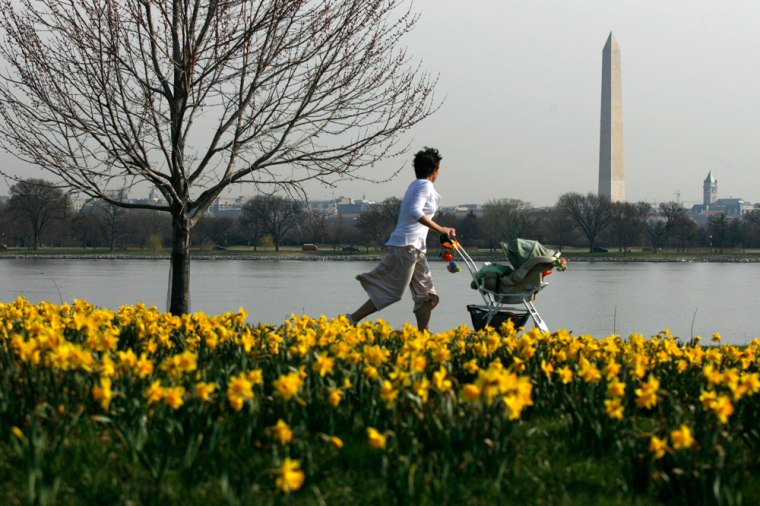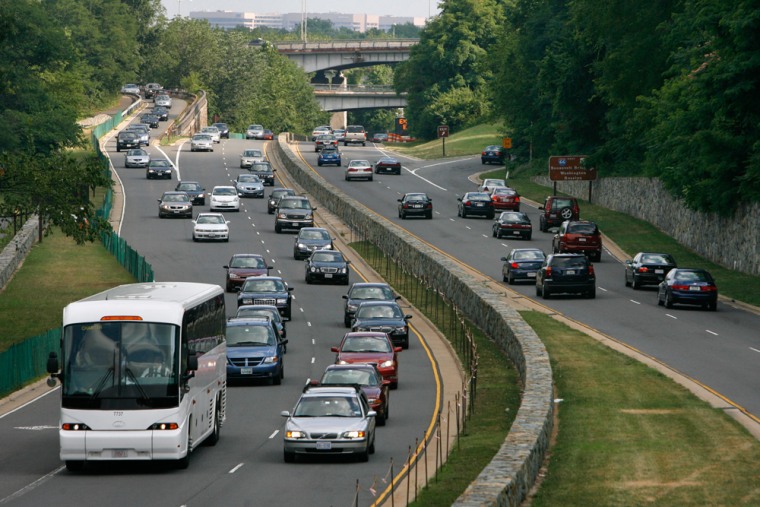Meandering through wooded hills, the George Washington Memorial Parkway offers stunning views of the Potomac River and the capital's monuments beyond. It also offers one of the most direct commutes to downtown Washington for suburban residents — and that has brought traffic it was never intended to handle.
Unlike an ordinary highway, the GW, as it's commonly known, can't just be widened, flattened and straightened to make room for more vehicles at higher speeds. The road is the property of the National Park Service, and its central mission is to showcase the area's historic sights and natural beauty.
Around the country, old parkways designed mainly with aesthetics in mind are bumping up against modern realities, turning scenic roads into hotbeds of commuter frustration and treacherous driving.
Parkways ill-suited for heavy traffic
Classic parkways are ill-suited for heavy traffic because they often contain sharp curves and steep hills and lack features like merge lanes. The challenge for the agencies overseeing them is to balance their historic and scenic value with the need for safe and free-flowing arteries.
"It's a real balancing act. It always has been, and it becomes more so as traffic increases," said Jon G. James, acting superintendent of the GW, which will celebrate its 75th anniversary as a National Park Service site next month.
The road runs 25 miles in northern Virginia from the Capital Beltway to George Washington's Mount Vernon estate, with two lanes in each direction. The smaller Clara Barton Parkway in Maryland across the Potomac is also part of the GW.
Park officials estimate that 75,000 to 80,000 vehicles drive on the parkway every day — far more than intended.
The GW is not alone in its beauty or its challenges. In the densely populated suburbs of New York City — where the nation's first parkway, the Bronx River Parkway, opened in 1925 — a network of scenic highways showcases rivers, rolling hills and dramatic cliffs.

Those roads have grown to become key commuter arteries. On the southern portion of the Taconic State Parkway, for example, average daily traffic has increased from 44,000 in 1981 to 106,000 in 2003.
In Connecticut, the picturesque Merritt Parkway features bridges representing Art Moderne, Art Deco, Classical, Gothic and Renaissance architecture. In the 1990s, officials considered widening the road to cope with traffic growth on the key conduit toward New York City, but preservationists blocked the effort, said Jill Smyth, executive director of the Merritt Parkway Conservancy, an independent nonprofit that grew out of that fight.
On the West Coast, the Arroyo Seco Parkway follows a dry riverbed from Los Angeles to Pasadena. With large bands of parkland running parallel to it and several historic monuments located off it, the parkway is considered California's first freeway. Like the GW and the Merritt, it is recognized under the America's Byways program administered by the Federal Highway Administration. But critics say it has been poorly adapted to handle today's traffic, contributing to frequent accidents.
Model for future construction
Despite their practical flaws, parkways are important to preserve and can even provide a model for future construction, advocates say.
"The experience of driving doesn't have to be terrible. There's still room for beauty and enjoyment," said Kevin Fry, president of Scenic America, a nonprofit dedicated to preserving the nation's "visual character." Fry's group advocates flexibility in road construction and upgrades. Such compromises can be used to improve safety features of parkways while still maintaining their aesthetics.
On the GW parkway, guard rails, which were not part of the original design, have been added. But rather than using metal fixtures, the park service used steel-backed timber to give them "a more rustic, historic appeal," James said.
The latest project on the GW is reconstruction of the Humpback Bridge, near the Pentagon, to make it wider and improve visibility. There, the contractor is trying to incorporate the original stone work in the new bridge, James said.
In New York, shoulders have been added on parkways. But rather than add an 8- to 10-foot swath of pavement, officials have opted to make them half paved and half grass.
But in some cases, practical concerns have won out over ambiance. The Taconic, for example, remains largely unchanged on the lightly traveled northern portions approaching Albany, but is a much different road on the portions near New York City, where it has been expanded from two lanes in each direction to three or four.
"We've had to reconstruct it and improve the alignment, and for sure it has lost a lot of its original character," said Sandra Jobson, a spokeswoman for the New York State Department of Transportation.
The GW is unlikely to be changed as dramatically, since the National Park Service sees "park" as the operative word in "parkway."
A 'beautiful way to commute'
Even drivers who use the road more for transportation than for pleasure say they appreciate it for what it is.
"It's a beautiful way to commute even if there's cars around you," said Ellen Walter, who lives near the parkway in Alexandria. "It's pretty. It's green. A lot of times there's pretty birds."
Still, there are concerns that the current levels of commuter traffic compromise safety, since commuters tend to ignore the posted speed limits of 25 mph to 50 mph.
"If commuters want to drive on the parkways, that's fine, but they have to drive on them as parkways, not the beltway," said Dan Marriott, a historic roads consultant, adding that he would like to see more aggressive speed enforcement. Efforts to limit rush-hour traffic through tolls or high-occupancy requirements might also be worth considering, he said.
James said he too wants drivers to slow down and notice what's outside their window. The park service's two priorities are visitor safety and letting people appreciate the sights, he added.
"If people would drive the speed limit," he said, "we would be solving both things at once."
